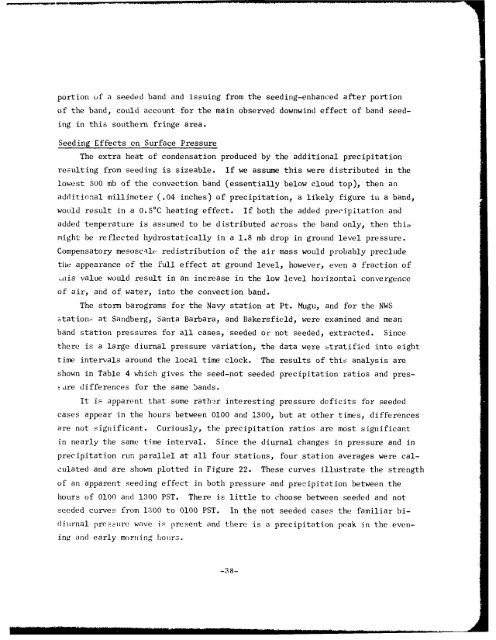pages - The Black Vault
pages - The Black Vault
pages - The Black Vault
- No tags were found...
You also want an ePaper? Increase the reach of your titles
YUMPU automatically turns print PDFs into web optimized ePapers that Google loves.
portion of a seeded band and issuing from the seeding-enhanced after portionof the band, could account for the main observed downwind effect of band seedingin this southern fringe area.Seeding Effects en Surface Pressure<strong>The</strong> extra heat of condensation produced by the additional precipitationresulting from seeding is sizeable. If we assume this were distributed in thelowest 500 mb of the convection band (essentially below cloud top), then anadditional millimeter (.04 inches) of precipitation, a likely figure ill a band,would result in a 0.5 0 C heating effect. If both the added precipitation andadded temperature is assumed to be distributed across the band only, then thiomight be reflected hydrostatically in a 1.8 mb drop in ground level pressure.Compensatory mesoscale redistribution of the air mass would probably precludethe appearance of the full effect at ground level, however, even a fraction ofaiis value would result in an increase in the low level horizontal convergenceof air, and of water, into the convection band.<strong>The</strong> storm barograms for the Navy station at Pt. Mugu, and for the NWSstation5 at Sandberg, Santa Barbara, and Bakersfield, were examined and meanband station pressures for all cases, seeded or not seeded, extracted. Sincethere is a large diurnal pressure variation, the data were Atratified into eighttime intervals around the local time clock. <strong>The</strong> results of this analysis areshown in Table 4 which gives the seed-not seeded precipitation ratios and presauredifferences for the same bands.It is apparent that some rather interesting pressure deficits for seededcases appear in the hours between 0100 and 1300, but at other times, differencesare not significant. Curiously, the precipitation ratios are most significantin nearly the same time interval. Since the diurnal changes in pressure and inprecipitation run parallel at all four stations, four station averages were calculatedand are shown plotted in Figure 22. <strong>The</strong>se curves illustrate the strengthof an apparent seeding effect in both pressure and precipitation between thehours of 0100 and 1300 PST. <strong>The</strong>re is little to choose between seeded and notseeded curves from 1300 to 0100 PST. In the not seeded cases the familiar bidiurnalpressure wave is present and there is a precipitation peak in the eveningand early morning hlours.-38-





![Combat Support in Korea [270 Pages] - The Black Vault](https://img.yumpu.com/49796461/1/190x71/combat-support-in-korea-270-pages-the-black-vault.jpg?quality=85)










